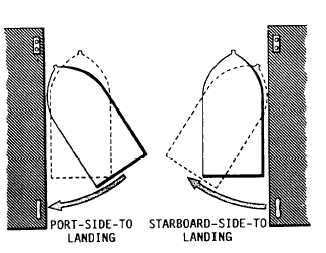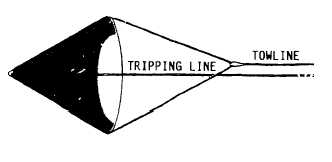| |
side force of the backing screw on the stern will walk
your stern alongside. If you have to go starboard-side-to,
remember that you must come alongside much
straighter, because the backing screw will walk your
stern away from the landing. Make a starboard-side-to
landing at slow speed, and work your engine and rudder
to get the boat alongside.
When tying up to a ship's gangway in a tideway or
stream, always secure the boat line to the ship side of
the bow, and set the rudder a little away from the ship,
so that the boat will ride clear. Tie up to a deck or landing,
bow-on to the stream whenever possible, so you can set
your rudder to hold it off in the same manner as just
described. If the wind tends to throw the boat onto the
landing, use less rudder and speed, and use your fenders
to keep from chafing the boat against the pilings. Tie up
with a bow line leading forward and stern line leading
aft. Never have both lines leading in the same direction.
In getting underway from a starboard-side-to
landing, usually it is best to back until the stern has
walked itself away from the dock, because a
single-screw boat will back to port. If you have no room
astern, hold the bow by the bow line and go ahead slowly
with a hard right rudder. When your stern is well out,
cast off, back with a hard left rudder, and your stern will
walk out without difficulty.
CAUTION
When you are shoving a boat away from the
pier, the bow and the stern could fall in the
water.
Figure 5-9.–Effect of backing propeller.
NORMAL AND HEAVY SEAS
With normal sea conditions, steering a powerboat is
much the same as handling a single-screw ship, although
the reactions of the boat to the engines and rudder are
more pronounced. Too much weight forward may cause
the bow of the boat to plunge into the waves.
Some hints on handling powerboats under special
circumstances are given here as an aid to a boat crew
that, having mastered the elements of its work, is ready
to operate in more complicating situations.
When handling boats in a moderate or a rough sea,
you must exercise caution, good judgment, and
seamanship. Each member of the boat crew must know
and perform all duties well to ensure the safe operation
of the boat at all times.
One of the most risky situation arises when a
powerboat is running before a sea. When the hull is lifted
by the stern, there is danger that steerageway and power
may be lost when the screw and rudder are clear of the
water. The boat may then swing around broadside to the
seas. The coxswain must rely on skill and training in the
use of the rudder to keep the stern to the mountains of
water. It is helpful to reduce speed and to allow large
swells to roll by. In extreme cases, a drogue or sea
anchor (fig. 5-10) may be used.
Running into a sea is less hazardous, but not without
danger. Reduced speed lessens the strain on both engine
and hull. To this end, the throttle should be adjusted so
that the bow rises with oncoming waves instead of
driving into them. Taking the seas on either port or
starboard bow is sound seamanship, too, because some
of the pitch is lessened by this method.
Avoid the trough, except in an emergency. When
moving broadside to waves, turn the wheel
momentarily, so as to take larger wave crests on the
windward bow, and return to the course when conditions
permit.
Figure 5-10.–Sea anchor or drogue.
5-10
|


